Did you know that nearly 70% of motorcycle owners experience frustrating—and often expensive—rust damage after a single season of winter storage? If you want to keep your motorcycle in good condition year-round, understanding how to protect your motorcycle from rust during winter is crucial. This guide dives into proven steps, smart product choices, and expert insights to safeguard your ride throughout the colder months, allowing you to avoid the headaches most riders face and enjoy a gleaming, rust-free bike come spring.
Did You Know? Most Motorcycle Owners Face Costly Rust Problems During Winter Storage
Every winter, a significant number of motorcycle owners underestimate the toll cold weather and improper storage can take on their prized machines. Cold weather introduces increased humidity and fluctuating temperatures in garages, while road salt lingering on surfaces becomes another major risk factor. These elements interact to create the perfect conditions for rust and corrosion. Ignoring preventive measures may allow hidden moisture to accumulate on metal parts , silently causing rust that leads to expensive repairs. Consider this: A minor patch of rust can quickly spread and degrade vital components, risking both safety and value.
Whether you plan to store a motorcycle in your garage or a storage unit, understanding the challenges of winter storage is the first step to taking proactive measures. Practical examples abound—owners who skip a thorough pre-storage wash or use an airtight cover often discover bubbling paint, compromised chrome, or stubborn rust on chrome pipes when spring arrives. Recognizing these risks right now makes a world of difference for your bike’s appearance and longevity.

Understanding How to Protect Your Motorcycle From Rust During Winter Storage
To shield your motorcycle from rust during winter, you need a comprehensive approach that addresses cleaning, moisture control, and correct storage methods. Proactive strategies include routine cleaning, anti-rust treatments, and choosing the right storage environment. These simple actions work together to minimize contact with moisture and airborne particles that could settle and start causing rust . Neglecting any one part of the process can compromise the entire effort, allowing corrosion to develop during winter storage .
Metal components —especially those not treated or properly coated—are particularly susceptible in winter months. Salt residue on roads or in the air can settle on exposed surfaces and, mixed with condensation from temperature changes, lead to rust . Thoroughly understanding each step and executing it with care is the most reliable way to ensure your motorcycle emerges from storage in good condition .
What Is Motorcycle Rust And Why Is Winter Storage Critical?
Rust forms when iron, oxygen, and moisture interact, creating an electrochemical reaction that breaks down metal parts . During winter storage, the risks intensify—especially when motorcycles are stored in humid, poorly ventilated, or cold environments. Moisture lingers, often invisible to the naked eye, and, when combined with road salt, exacerbates rust and corrosion .
The winter months are especially critical because bikes remain stationary for long periods. Without routine movement or checks, undetected moisture or contaminants can affect your motorcycle in winter. Components like the frame, exhaust, and wheels can rapidly deteriorate if not protected, leading to costly repairs or replacement come spring. Taking the time to prevent rust before storing your motorcycle is a smart investment in your ride’s future.
-
Exposure to road salt and moisture
-
Lack of proper ventilation
-
Improper cleaning before storage
What You'll Gain: How to Protect Your Motorcycle From Rust During Winter
-
Learn how to protect your motorcycle from rust during winter
-
Understand best winter storage practices
-
Discover actionable steps to prevent rust and prolong your motorcycle's lifespan
-
Avoid common mistakes with motorcycle in winter storage
The Science Behind Rust: How Cold Weather, Road Salt, and Moisture Contribute
Understanding the science of rust is essential for effectively protecting your motorcycle in winter. Cold weather can cause condensation inside your garage or storage unit, especially when fluctuating temperatures bring airborne moisture into contact with cold metal surfaces. As these damp conditions persist, any trace of road salt clinging to your motorcycle will attract and hold moisture, speeding up the onset of rust and corrosion.
Many riders overlook the destructive combination of humidity, road debris, and occasional temperature spikes. These factors activate chemical reactions on untreated or minimally protected surfaces. Not only do these reactions tarnish your motorcycle's finish, but they can also weaken critical parts, such as the frame, fork, and exhaust—resulting in unforeseen repair bills and lost riding time once warmer days return.
How Cold Weather and Humidity Accelerate Rust on Your Motorcycle
Cold air may feel dry, but as temperatures drop, humidity inside your storage area can settle invisibly on metal components . This is especially true in garages that aren’t climate controlled. Even small amounts of trapped moisture will adhere to metal parts, where it can freeze and thaw several times over, subtly expanding and creating micro-cracks in the finish. Over time, these weak spots become the starting point for rust, quickly spreading and causing rust that damages your motorcycle during winter storage.
Humidity control is a cornerstone of effective winter storage. If you store your motorcycle in a damp or unventilated area, condensation can build each time the garage door opens or the temperature shifts. To prevent moisture , it’s best to keep your motorcycle in a dry place and regularly inspect for any signs of frost, dew, or water droplets on its surfaces. The simple habit of checking for moisture buildup may save you from dealing with widespread rust once the winter months are over.
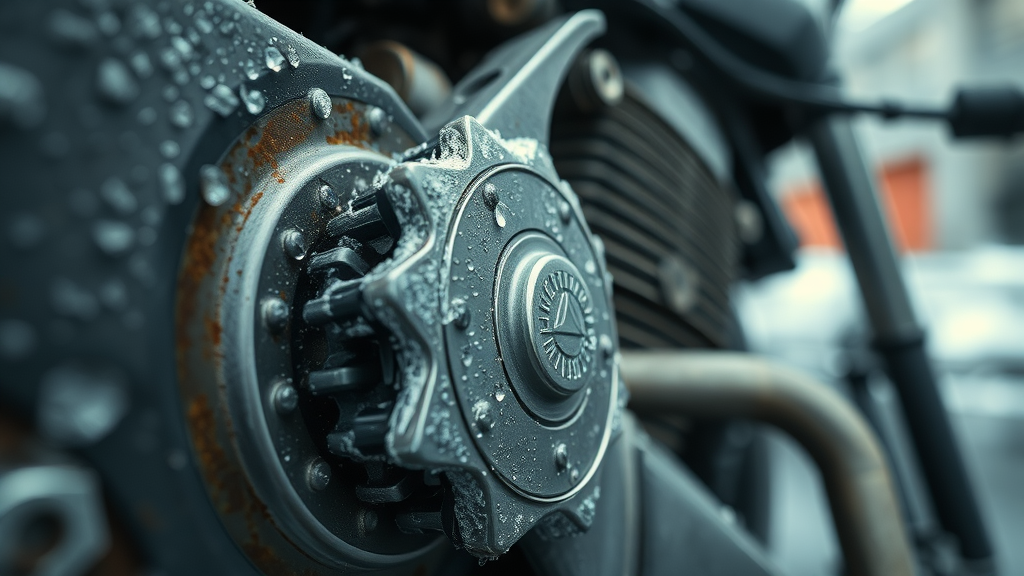
The Dangerous Effects of Road Salt on Motorcycles in Winter
Road salt is the silent enemy hiding on your motorcycle’s undercarriage after even a short winter ride. While salt keeps roads safer, it’s extremely corrosive to exposed metal parts . When combined with moisture from snow, ice, or condensation, it creates an aggressive chemical cocktail that will rapidly eat away at metal surfaces. Even a trace amount left on swingarms, brake discs, or the exhaust system can lead to rust throughout the winter months.
Experts always advise a meticulous wash before winter storage. Forgetting this critical step means every nook and cranny that touches salted pavement is at heightened risk. When spring arrives, the damage caused by months of unchecked salt exposure can mean hours of restoration work—or worse, the replacement of whole parts. Always thoroughly rinse and dry your motorcycle to banish every last bit of salt.
"Road salt and trapped moisture are the main enemies of motorcycle longevity during winter storage." — Industry Expert
Pre-Storage Checklist: How to Protect Your Motorcycle From Rust During Winter
Following a comprehensive checklist is your best defense when deciding how to store your motorcycle for winter. Each step in the process supports the next, creating a complete shield against the environmental factors that cause rust and corrosion . Skip an item, and you risk undermining your bike’s protection. With proper preparation, you can keep your motorcycle in good condition all winter.
-
Thoroughly clean your motorcycle: Remove all debris, grime, and road salt from every exposed surface, paying close attention to crevices and undercarriage.
-
Dry all components: Use a leaf blower, compressed air, or clean towels to eliminate hidden moisture from hard-to-reach spots.
-
Inspect for existing rust: Scrutinize metal components for discoloration, pitting, or rough spots—treat early signs immediately with rust remover or preventative spray.
-
Apply protective layers: Use a corrosion inhibitor, wax, or anti-rust sprays to coat all vulnerable areas thoroughly.
-
Maintain tire pressure: Inflate tires to the recommended pressure to prevent flat spots and keep them ready for riding when spring arrives.
Why You Must Clean Your Motorcycle Before Winter Storage
Cleaning your motorcycle before putting it away for winter isn’t just a good idea—it’s absolutely necessary to prevent rust and ensure your bike stays in good condition . Dirt, road grime, and residual salts cling to every curve and crevice, holding onto moisture long after your last ride. When these contaminants remain in place, they become magnets for rust, corroding both visible and hidden metal components during winter storage.
A meticulous cleaning regimen is your first and strongest defense. Use specialized motorcycle cleaners, degreasers, and gentle brushes to get into tight spots. Rinse thoroughly, making sure all soapy residue is gone. Pay special attention to the underside and wheels, as these areas are most likely to harbor damaging traces of road salt . After cleaning, always dry the bike completely—using air tools to blow water from under the seat, around bolts, and in vented components—to prevent moisture from lingering where you can’t see it.
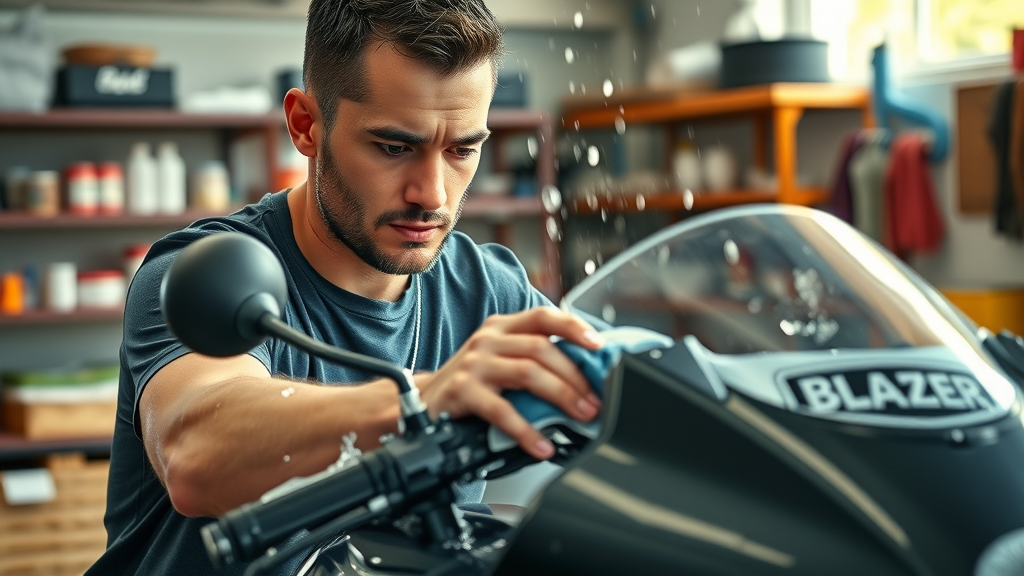
Inspect and Fix: Checking for Rust Before Storage
Rust caught early is easier and far less costly to treat, so inspection should follow cleaning in your winter storage routine. Carefully examine all metal parts—especially those showing faint discoloration or texture differences. Key areas to inspect include the frame, exhaust system, brake discs, chain, and areas near welds. If you find any traces of surface rust, use a rust remover product or gentle abrasive pads to remove it, then apply a rust-inhibiting treatment to the spot.
Do not overlook chrome surfaces or hardware, as these attractive finishes often mask tiny rust spots beneath the sheen. Once your inspection is complete, address any additional maintenance or repair needs, such as tightening bolts or lubricating moving parts, so your motorcycle remains protected and ready for spring. A thorough pre-storage check not only mitigates rust risks but also increases the longevity and value of your machine.
Essential Products that Prevent Rust During Motorcycle Winter Storage
The right products make a significant difference in your quest to prevent rust on your motorcycle during winter. Modern chemical formulations are designed to create barriers against moisture, salt, and corrosive elements. Some products are spray-on treatments that cover every exposed surface, while others add layers of wax or silicone for extra protection. Combined with a high-quality motorcycle cover, these products keep your motorcycle in winter ready for anything the season throws its way.
|
Product |
Purpose |
Application Method |
|---|---|---|
|
Corrosion Inhibitor Spray |
Prevents surface rust |
Spray on metal parts |
|
Motorcycle Cover |
Shields against moisture |
Cover tightly |
|
Wax |
Extra protective layer |
Apply after wash |
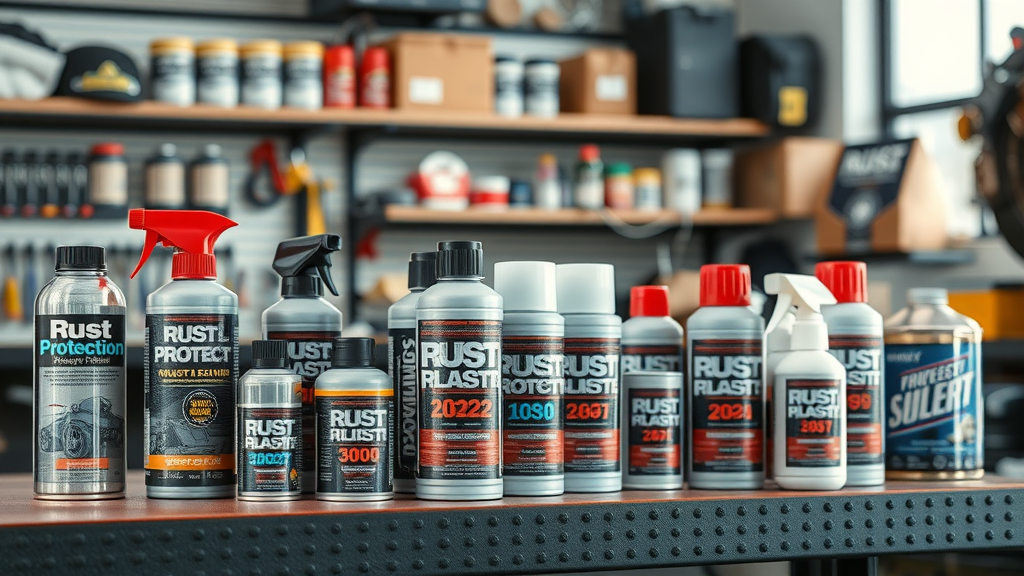
Choosing The Right Place to Store a Motorcycle During Winter Storage
Not all storage solutions provide the same protection against winter’s harsh elements. Your choice between a home garage and a storage unit impacts not only convenience but also your ability to prevent moisture and maintain safe conditions for your bike. Ideally, your motorcycle should be stored in a dry place with limited temperature fluctuations and adequate ventilation. Secure storage also deters theft and accidental bumps, making it the most responsible way to keep your motorcycle in winter safe from harm.
Before making a choice, consider factors such as climate control, risk of leaks or flooding, and how easily you can check on your motorcycle during storage. If you’re uncertain, seeking professional advice or renting a climate-controlled storage unit is a good idea for maximum peace of mind.
Storage Unit vs. Home Garage: Best Options for Keeping Your Motorcycle in Winter
A home garage is convenient and cost-effective, allowing you to check on your motorcycle regularly, run a trickle charger, and easily access cleaning tools. However, garages can lack humidity control and may be more susceptible to wide temperature fluctuations and trapped moisture—both of which lead to rust . Enhancing insulation, sealing gaps, and using a dehumidifier can improve a garage’s protection capabilities immensely.
A dedicated storage unit, particularly one with climate control, offers consistent temperatures and humidity levels—a dream scenario for any rider seeking to prevent rust . Storage units tend to be less accessible but provide strong protection from freezing temperatures, theft, and vandalism. Evaluate local options and select a facility with a strong reputation, solid security, and routine maintenance checks for optimal results.
How to Set Up a Storage Unit for Rust Protection
Setting up your storage unit with rust prevention in mind is a proactive step many overlook. Start by choosing a unit with solid ventilation and minimal exposure to external dampness. Lay down a plastic tarp, racedeck flooring, or waterproof mat to create a barrier between your motorcycle and the concrete floor, which can transmit moisture upwards. Place moisture absorbers—such as silica gel bags or calcium chloride containers—around the motorcycle to further prevent moisture in the air from condensing on metal surfaces.
Cover all vents, cracks, or gaps in the unit to keep out snow and cold drafts that bring extra humidity. Position your motorcycle so it is off the ground if possible, either by using a paddock stand or a piece of wood beneath the tires. Check on your motorcycle periodically throughout the winter months to ensure no condensation, leaks, or pests have infiltrated the unit and compromised your storage plan.
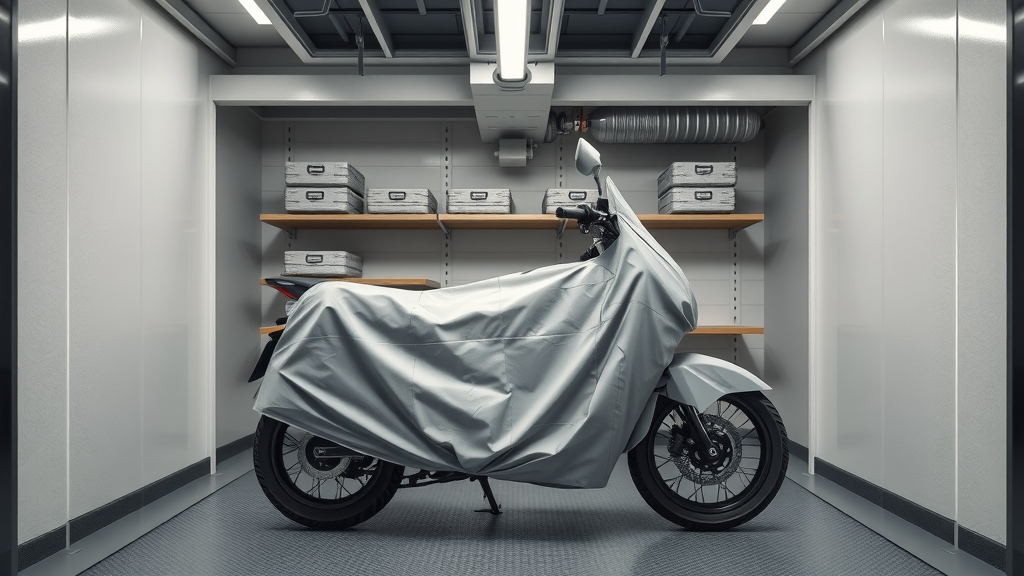
Protect Your Motorcycle with Effective Covering Techniques
Covering your motorcycle acts as the final, crucial shield between your bike and the elements during winter storage. The right cover will keep dust, condensation, and errant moisture away from sensitive parts, further bolstering the effects of your cleaning and anti-rust treatments. Some riders make the mistake of choosing an airtight tarp, which traps moisture—but a breathable, waterproof cover is the superior choice for long-term protection in the winter months.
Before covering your motorcycle, make sure every step of the cleaning, drying, and treatment routine is complete. Cover your motorcycle securely, ensuring the fit is snug but allows some air circulation. Tuck in all loose material to prevent drafts or pests from getting under the cover, and double-check fastenings so the wind doesn’t dislodge it.
Should You Cover a Motorcycle in the Winter? Pros and Cons
Covering your motorcycle in winter is a good idea , but choosing the right type of cover determines how well you protect your motorcycle . Breathable covers allow air to pass through while blocking moisture—an essential feature, as trapped moisture can be just as dangerous as exposure to rain or snow. In contrast, non-breathable or fully waterproof tarps can create a greenhouse effect, causing condensation to build up inside and form rust on metal components .
Pros: Keeps out dust and debris; reduces the risk of accidental scratches; deters theft if the cover is locked in place; and, with proper breathability, helps prevent moisture buildup. Cons: If chosen poorly, a cover can actually trap humidity, leading to rapid corrosion. Always inspect your motorcycle periodically and adjust the cover if you detect dampness.
Ventilation and Moisture Control: Key Factors for Keeping Your Motorcycle Rust-Free
Ventilation is a non-negotiable aspect of winter motorcycle storage. Lack of fresh air invites condensation to settle on your bike. If you’re using a storage unit, make sure air circulates naturally by cracking a vent, periodically opening the door on dry days, or using a small fan. Moisture absorbers positioned around the bike further diminish the chance of rust, while wrapping sensitive electronics or chrome parts with vapor barrier paper adds another protective layer.
Garages without active ventilation should consider dehumidifiers or even a basic closet desiccant. Avoid running heaters or dehumidifiers unless you are present, as they may create uneven temperature zones within the enclosed space. The goal: keep your motorcycle in a dry place, monitor humidity levels, and avoid dramatic temperature swings throughout the winter months for optimal rust protection.
Ongoing Maintenance: How to Protect Your Motorcycle From Rust During Winter
-
Inspect periodically for moisture buildup
-
Reapply anti-rust sprays as needed
-
Rotate tires to prevent flat spots
Even while in storage, ongoing maintenance ensures your bike is ready when the snow melts. Month-to-month, visually check for condensation, moisture pools, or new signs of surface rust. Touch up corrosion inhibitors where needed, especially on exposed metal parts subject to movement or mechanical wear. Periodically rotate the tires to prevent flat spots—particularly if your motorcycle will be stationary for several months. Keeping a simple routine in place reduces surprises come spring.
Batteries also require attention during winter storage. Use a trickle charger or battery tender to keep your electrical system in good condition , and make sure the battery terminals are clean and free of corrosion. Top off tire pressure to the recommended pressure , as underinflated tires are particularly vulnerable to flat spots in freezing temperatures. These best practices, combined with vigilance, keep you on top of possible issues and ready for the first warm ride when spring arrives.
People Also Ask: How to Protect Your Motorcycle From Rust During Winter
How to keep a bike from rusting in winter?
Clean thoroughly, dry completely, use anti-rust sprays, store in a dry, ventilated area, and cover your motorcycle with a breathable material for optimal rust protection during winter.
Should you cover a motorcycle in the winter?
Yes, but use a breathable, waterproof motorcycle cover to prevent condensation and trapped moisture, which can contribute to rust formation during winter.
How do I prevent my motorcycle from rusting?
Prevent rust by cleaning and drying your motorcycle, applying protective coatings, avoiding contact with road salt, and storing it in a rust-resistant environment.
How to winter proof a motorcycle?
Winter proof your motorcycle by cleaning, inspecting for damage, lubricating moving parts, applying rust protectant, filling the tank, maintaining battery charge, and covering it securely.
Additional Tips: Expert Insights to Prevent Rust When You Store a Motorcycle
"A proactive approach to winter storage saves not just money, but your motorcycle's beauty and lifespan" — Veteran Mechanic
Don’t overlook the value of extra steps: Add a fuel stabilizer to your tank to prevent gumming, and gently move your bike within the storage space every few weeks to prevent sticking brakes and maintain part lubrication. Always double-check that the environment is free from plumbing leaks, roof drips, or unexpected sources of sensitive moisture. Investing in high-quality hydration or humidity monitors and reviewing motorcycle forums for product recommendations gives you an extra edge.
Key Takeaways for How to Protect Your Motorcycle From Rust During Winter
-
Always clean and dry your motorcycle before winter storage
-
Use anti-corrosion products and covers wisely
-
Monitor moisture and check your motorcycle periodically
Frequently Asked Questions About Motorcycle Winter Storage and Rust Prevention
Can I store my motorcycle outdoors during winter?
Storing your motorcycle outdoors during winter is not recommended, as exposure to rain, snow, and rapidly changing temperatures will dramatically increase the risk of rust and corrosion, even if you use a cover.
Is it necessary to remove the battery for winter storage?
It’s wise to remove the battery or use a battery tender during winter storage, especially if your motorcycle will not be checked frequently. Cold weather can drain battery life, while trickle charging maintains charge and extends the battery’s lifespan.
Will wax really help prevent rust on my motorcycle?
Yes, applying a high-quality wax adds an extra defensive layer to your motorcycle’s surfaces, sealing out moisture and making it more difficult for salts and contaminants to cling to exposed metal.
Secure Your Investment: Protect Your Motorcycle From Rust During Winter Storage Today
Act now to keep your motorcycle in pristine condition during the toughest months—clean, protect, and store with care, and your bike will be ready to ride the minute winter ends!
To further enhance your understanding of protecting your motorcycle from rust during winter storage, consider exploring these authoritative resources:
-
“How to Prevent Motorcycle Rust” : This article offers comprehensive strategies to shield your bike from corrosion, emphasizing the importance of minimizing exposure to salts, chemicals, and moisture. ( partzilla.com )
-
“Motorcycle Winter Storage” : This guide provides detailed steps for winterizing your motorcycle, including tips on covering exhaust pipes and investing in high-quality covers to protect against moisture and rust. ( amerifreight.net )
By consulting these resources, you’ll gain valuable insights and practical tips to ensure your motorcycle remains rust-free and in optimal condition throughout the winter months.
 Add Row
Add Row  Add
Add 
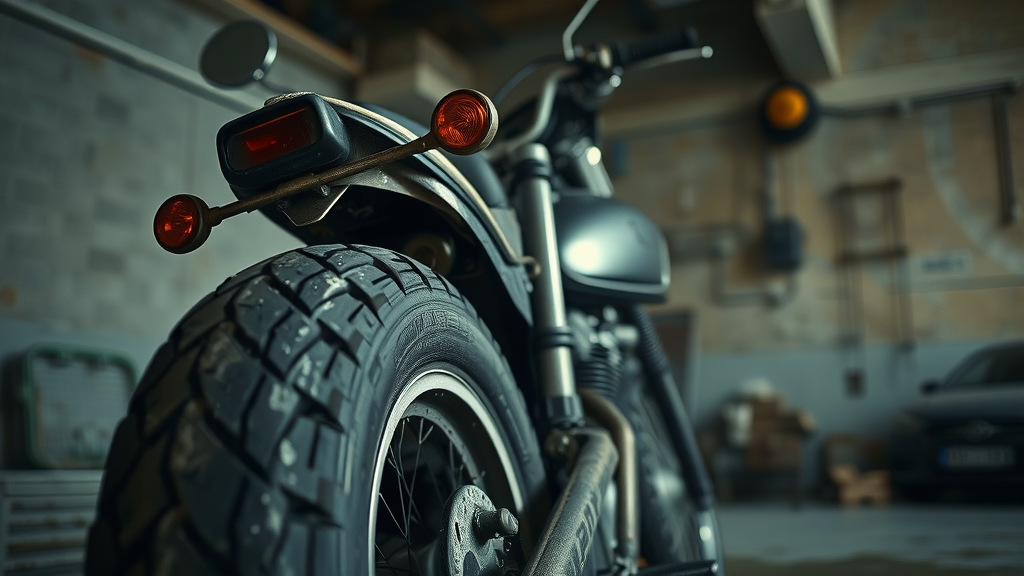
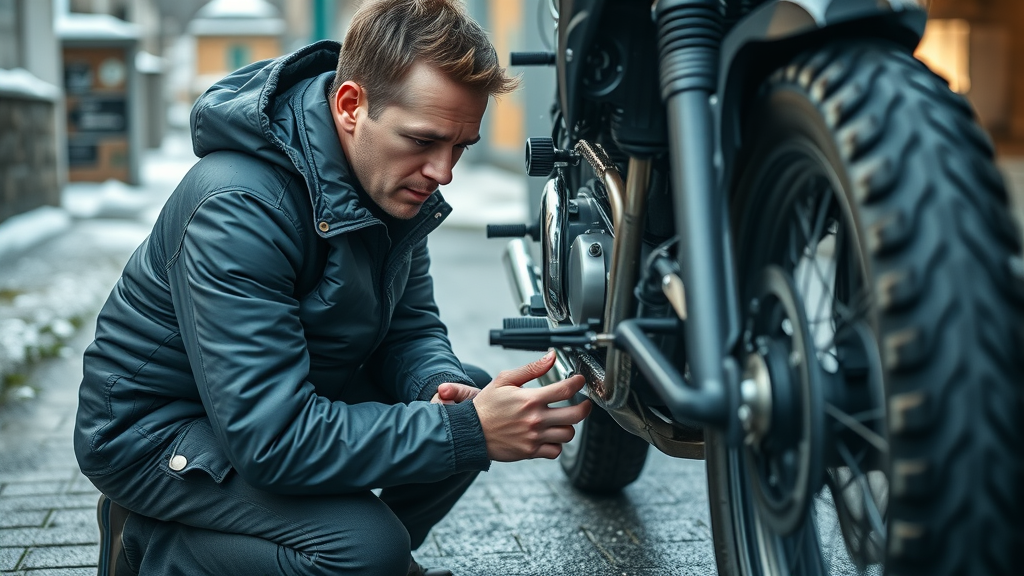

Write A Comment